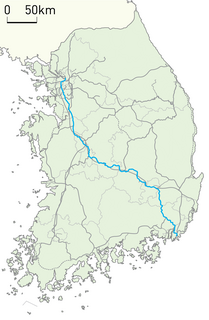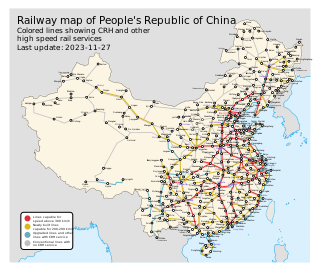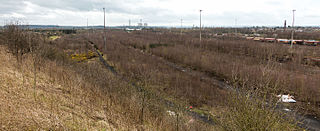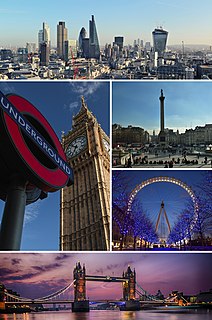
The Gyeongbu Line (Gyeongbuseon) is the most important railway line in South Korea and one of the oldest ones in the country. Gyeongbu line was constructed in 1905, connecting Seoul with Busan, via Suwon, Daejeon, and Daegu. The Gyeongbu Line is by far the most heavily travelled rail line in South Korea.

Watford Junction is a railway station that serves Watford, Hertfordshire. The station is on the West Coast Main Line (WCML), 17 miles 34 chains from London Euston and the Abbey Line, a branch line to St Albans. Journeys to London take between 16 and 52 minutes depending on the service used: shorter times on fast non-stop trains and slower on the stopping Watford DC line services. Trains also run to Clapham Junction and East Croydon via the West London Line. The station is a major hub for local bus services and the connecting station for buses to the Harry Potter studio tour. The station is located north of a viaduct over the Colne valley and immediately south of Watford Tunnel.

California High-Speed Rail is a high-speed rail system under construction in the U.S. state of California. It is projected to connect the Anaheim Regional Transportation Intermodal Center in Anaheim and Union Station in Downtown Los Angeles with the Salesforce Transit Center in San Francisco via the Central Valley, providing a one-seat ride between Union Station and San Francisco in 2 hours and 40 minutes. Future extensions are planned to connect to stations to San Diego County via the Inland Empire, as well as to Sacramento.

Regional Eurostar was the name given to plans to operate Eurostar train services from Paris and Brussels to locations in the United Kingdom beyond London. The services would have been run using a fleet of seven North of London, 14-coach British Rail Class 373/2 trainsets.

Superlink was a proposal for a new UK railway network to connect London, the south-east Midlands, East Anglia, and south-east England.

The international definition of high-speed rail encompasses lines with a top speed of at least 250 km/h (155 mph) and existing lines with a top speed of around 200 km/h (124 mph). As of 2011, there are four "classic" main railway lines in Britain operating at up to 201 km/h (125 mph), plus 108 km (67 mi) of purpose-built high-speed line.

Canada is the only G7 country that does not have high-speed rail. In the press and popular discussion, there have been two routes frequently proposed as suitable for a high-speed rail corridor:
This article lists planned or proposed high-speed rail projects, arranged by country. Although many nations have done preliminary feasibility studies, many lines are eventually shelved or postponed due to high cost, and only a few nations of those proposing are actively building high-speed rail lines. Planned or proposed lines are therefore separated here from lines that are under construction, some nations having both. High-speed rail is public transport by rail at speeds in excess of 200 km/h (125 mph).

High-speed rail (HSR) in China consists of a network of passenger-dedicated railways designed for speeds of 250–350 km/h (155–217 mph). It is the world's longest high speed railway network and is also the most extensively used.

High-speed rail in Australia has been under investigation since the early 1980s. Every Federal Government since this time has investigated the feasibility of constructing high speed rail, but to date nothing has ever gone beyond the detailed planning stage. The most commonly suggested route is between Australia's two largest cities, Sydney and Melbourne, which is the world's second busiest air corridor. Various corridors have been proposed for a potential high-speed line.

The Honam high-speed railway is a high-speed railway between Osong and Mokpo in South Korea. The line is a part of Korail's Korea Train Express (KTX) system, accelerating Seoul–Mokpo and Seoul–Gwangju KTX high-speed services which currently use the existing conventional Honam Line. On April 1, 2015, the line was inaugurated by the South Korean President Park Geun-hye with the attendance of 1200 invited guests and members of the public at Gwangju Songjeong Station in Gwangju, the line's terminus. The line diverges from Osong Station on the Gyeongbu high-speed railway, and stops at Gongju, Iksan, Jeongeup Stations. Journey times between Seoul and Gwangju has been cut from 2 h 40 min to just 90 min, making daily commuting possible. The Honam HSR is intended to bring business, and economic opportunities to the province of Jeollanam-do, which has seen slower development than other parts of South Korea. The line has been open to the public since April 2, 2015 for revenue service.
The Kuala Lumpur–Singapore high-speed rail (HSR) project is a currently postponed upcoming project to link Kuala Lumpur, Malaysia to Singapore via a high-speed rail line. It was announced by then Malaysian's Prime Minister, Najib Razak, in September 2010. Singapore's Prime Minister, Lee Hsien Loong, officially agreed in February 2013 to go ahead and the HSR project is expected to be completed by 2026. However, after the defeat of Najib Razak in Malaysia's Prime Minister elections in May 2018, his successor, Mahathir Mohamad initially announced that the project would be scrapped. However, during a visit to Japan on 12 June 2018, Mahathir said that the project was not scrapped but merely postponed due to high costs. On 5 September 2018, it was announced that the HSR operations will start in January 2031.

The Northern Hub is a rail programme in Northern England to improve and increase train services and reduce journey times between its major cities and towns by electrifying lines and removing a major rail bottleneck in Manchester. It is predicted to stimulate economic growth in the region. The project has several elements but the prime objective is to eradicate the bottleneck in Manchester and allow trains to travel through the city at speed without stopping. The project was announced as the Manchester Hub in 2009. The project's steering partnership involves Network Rail, Deutsche Bahn, First TransPennine Express, Northern Rail, East Midlands Trains, CrossCountry, Freightliner, the Department for Transport, Transport for Greater Manchester and Merseytravel.

East Midlands Hub is a planned new railway station on the Leeds Branch of High Speed 2. It is intended to be located on the existing railway sidings in Toton, situated between Nottingham and Derby. A connection to the Nottingham tram system and new connections to existing rail services are proposed, to link the station to Nottingham, Derby and Leicester railway stations. The station would be located adjacent to the M1 motorway in Nottinghamshire, on the border with Derbyshire.

High Speed 2 is a planned high-speed railway line connecting the city centres of Birmingham, Manchester and Leeds. The railway is to be delivered in two phases:

Northern Powerhouse Rail (NPR) previously called High Speed 3 (HS3) or Crossrail for the North is a proposed railway network in the North of England. It aims to improve transport connections between major northern English cities and transport hubs, including Liverpool, Manchester, Manchester Airport, Leeds, Bradford, Doncaster, Huddersfield, Sheffield, Newcastle, and Hull, as well as other significant economic centres. The exact route as yet has not been determined.
This article delineates the relationship between infrastructure and various economic issues.

















